Sabine de Raaf, an art therapist from the Netherlands contacted me about re-printing an article in which she was a contributor. It’s a great article, and definitely deserving of a reprint. Thanks to Sabine de Raaf for sending this along…
BANGKOK POST, OUTLOOK, Thursday March 13, 2008
Art of healing
Aesthetics and art therapy activities can help young offenders gain a new lease on their lives
STORY BY KARNJARIYA SUKRUNG, PHOTOS BY SOMKID CHAIJITVANIT
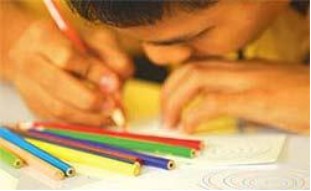
The assignment was to create a seal out of a lump of clay. But Pat, a 14-year-old boy, had decided to produce a family of seals. He made seals of different sizes: A big one in the centre, several medium-sized ones near it and some tiny seals on the back of the big, centre animal. “This big figure is the mother seal, and the rest are her children,” explained Pat, a crew-cut boy wearing the mandatory yellow T-shirt and navy-blue pants uniform.
“Where is the father seal then?” asked a psychologist who was observing the art therapy process in action at the three-day special workshop held inside the compound of the Pathum Thani Provincial Court (Juvenile and Family Section). Pat grinned, “He ran away with another woman.” Chuckling, he looked at the questioner. “He is irresponsible.”
A lull followed as Pat continued perfecting his sculptures, while psychologists, social workers and court officials jotted down notes.
Pat’s answer may provide an important clue that could help authorities improve the process aimed at healing him and fellow detainees while they are in the remand home, so that, hopefully, they will never be sent here again.
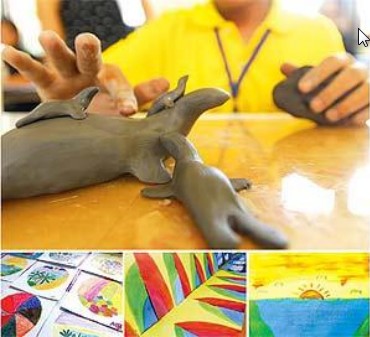
Works from the art therapy process reveal and heal the inside worlds of young offenders _ their yearning for love and understanding, their lack of problem solving skills and hope for the new chapter of life.
“The art therapy process helps uncover the complex nature of the youngsters’ hearts, where the problems lie,” said Sabine de Raaf, an art therapist from the Netherlands.
“Unless we are able to learn the roots of what brought them here to this detention centre, we cannot find ways to help them,” she added.
Sabine offered art therapy sessions to young offenders at the Pathum Thani Provincial Court (Juvenile and Family Section) during the five months that she was a volunteer teaching at Tridhakasa School.
Young offenders and the crimes that they commit reflect social ills, said Kornkanya Suwanpanich, chief judge of the Pathum Thani Provincial Court (Juvenile and Family Section).
“Most of these youngsters are from poor and broken families. Their parents and guardians are busy making ends meet, thus having little time for their kids to guide them through the maze of right and wrong,” she said. Many suffer from abuse by family members.
The other culprits, the chief judge pointed out, are consumerism values in society and irresponsible media.
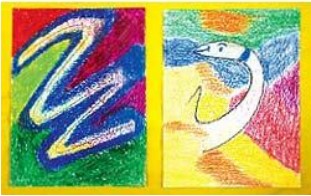
The ability to handle the black marks on their pictures reflects the youngsters’ ability to deal with difficulties in real life. In the left picture, the black mark is bolded and separated from other colours, while the right picture shows the ability of youngsters who can turn the black line into something funny, making it part of the whole picture.
“Many young people steal because they want to be accepted in society. They want to have the brand-name cellphones and to wear the fashionable clothes splashed in the media and advertisements,” added Kornkanya.
The situation seems worsen every year. Divorce rates and family-related lawsuits are on the rise. Last year, there were 915 new cases in the Juvenile and Family Court, 200 more than the number five years ago.
The most common crimes that result in 10- to 18-year-old youths being sent to remand homes are theft, violent and brutal rows, sexual offences, online and Internet addiction, gambling, drug abuse and truancy.
Punishment is not the cure for the rising crime rate among the young.
“If we want to help these young offenders, we need to change our attitude,” said Usa Thanomphongphan, director and founder of Tridhaksa School, who initiated the art therapy project for youth in correctional institutes.
“There are no evil or bad people in this world. They are just weak people who cannot get through life’s temptations and challenges. They need empowerment.”
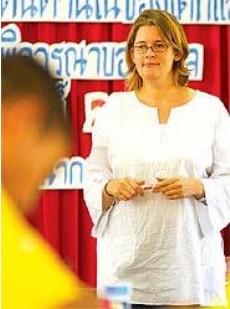
Sabine de Raaf, art therapist from the Netherlands: ”Art therapy provides processes to help us find our natural healing powers.”
“Humans are creative beings. We can always create and re-create our life. If people believe in their own potential, they can, and will, change for the better,” said Usa. In a “give and take” activity, art therapist Sabine asked each of the boys to draw an outward spiral on a small sheet of paper and an inward spiral on another small sheet of paper. Then she asked them to write inside the first spiral what they wanted to give to the world and, inside the other spiral, what they want to receive from the world.
The aggressive, ignorant-looking boys wrote almost in unison: “Love, warmth, hugging, caring, intimacy, happiness, flowers and sincerity” inside both spirals.
It is this evidence that convinces her that these boys can be healed and become good citizens in society.
“Art process activities help them to reach out with their hearts and feelings,” said Sabine. During her eight years of service as an associate judge of the Juvenile and Family Court in Rayong province, Usa learned a lot about social problems through the crimes committed by children. She supported several youths in renewing their lives. Yet she found a missing link in the rehabilitation process.
“We’ve been thinking that poverty and lack of education are the important underlying causes that put people into jail. We provide education programmes and vocational skills for inmates and juvenile delinquents, but many of them keep coming back to jail. I asked myself: ‘Why?”‘
The answer came one day when a young man she had supported was re-arrested for burglary. “I asked him why he had committed the same crime again when he already had a decent job, some money, and had been re-educated. I just didn’t understand why,” she recalled.
“The young man’s reply was that when things went rough, when he felt down in the dumps, he didn’t know what to do, how to deal with difficult situations – he felt worthless and empty inside.”
The answer took Usa on another turn in her life. Since then, the former judge and erstwhile businesswoman has dedicated herself to learning how to enhance the human spirit and its potential. She established Tridhaksa School eight years ago.
“I realised then that all of us need more than just things to get by in life. We need to fulfil our hearts and spirits. To live a life of balance in thinking, feeling and being willing,” she said.
“And we haven’t given our children enough of these.”
In 2006, she extended the merits of art therapy from the school to troubled youths in correctional and rehabilitation institutes.
She launched pilot project to introduce an art-for-self-transformation series for use by psychologists and social workers who work in remand homes and correctional institutes. The process covers sculpture, painting, music, poetry, and body and vocal movements. “Each art process event stimulates the desirable qualities of human beings, such as, for example, creativity, caring and compassion, patience, concentration, flexibility, and team work.
“Also, these processes can rid us of unpleasant behavioural traits such as aggression, stress and obsession,” said Usa.
Many troubled youths lack problem-solving skills. In an activity, Sabine asked the boys to colour the paper with crayons. They could draw any abstract patterns and forms that they liked. Then she asked them to close their eyes. When they opened their eyes again, they saw black marks on their work.
“Our life is not always what we want it to be. Sometimes things don’t go the way we plan or expect them to be, or some people may hurt us. How should we respond to these problems and uncertainties in life?” Sabine explained that the black crayon marks represented such mishaps in life.
How each boy coped with the blemishes on his drawing was key to understand his traits in handling problems, explained Sabine.
“Some can incorporate the black lines as part of their pictures. Some combine them with other colours to make a sail, an eel, a mountain, a ghost or a fish. This shows that they can embrace problems as part of their life. Even better, they can make fun of bad situations,” she said.
However, there were some boys who chose to bold the black lines, or tried to erase them.
“They are likely to be obsessed with problems. They hate difficulties and obstacles. These children are likely to suffer when things go wrong. They want things to always go their way, and they cannot cope with disappointments,” Sabine explained.
The art therapy process reveals the complex nature of youngsters’ hearts. Psychologists and social workers can use this information to try to eliminate undesirable behavioural traits.
A 17-year-old boy, charged with robbery and murder, shut himself off to the world, which made a psychologist’s job very difficult. But after taking art therapy for more than a year, the young man started to speak out to Jarunee Tung, a psychologist at Baan Karuna, who had participated in art therapy carried out at Tridhaksa School for a year. She learned that his parents had separated and had left him with an aunt since he was a toddler. His aunt was abusive to him, mainly verbally. At 13, the boy ran away and joined a gang. Later, he robbed and killed a middle-aged woman who always scolded him.
“He felt worthless. He had no goals and he saw no future in life whatsoever. This same feeling is shared by many young offenders. That’s why they don’t care what will happen and are ready to do any daredevil things,” she said.
“We tend to reprimand our children when they do wrong, but when they do good, we bypass the compliments. That’s partly why our kids have self-doubt and seek out acceptance from their peer, even if it means committing crimes,” she commented. Currently, she said, this young man aimed to finish non-formal education and once he is out of the remand home, he intends to become a mechanic.
“It is very important to establish a sense of self-worth and esteem among children and youth. Help them realise their potential and support them towards their life’s goals,” said Jarunee.
So far, the chief judge of the Pathum Thani Court said, youngsters who joined art therapy sessions have not yet made a comeback.
“Once they understand themselves and know where they are heading to in life, it helps them not to repeat their wrongs. But as important is their family. Youngsters who have supportive families are lucky and unlikely to return here again,” said Kornkanya.
The three-day art workshop ended. All works were put on display in a room which was turned into an exhibition hall. Young participants – artists – explained their works to court officials, psychologists, social workers and their peers.
“I feel relaxed, comfortable and free. I’m proud that people are interested in my work,” said Tum. He explained his mandala paintings with portraits of the Buddha and Satan.
“This is life, I think, the constant combat of good and evil.”
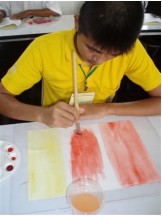
Very concentrated and dedicated the youngsters paint, draw and model clay. Sabine de Raaf explains and educates the social workers and psychologists on how to work with art and juveniles.
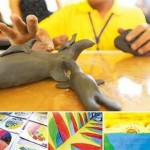
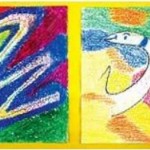

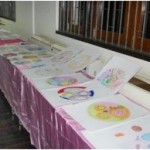

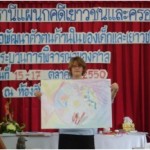

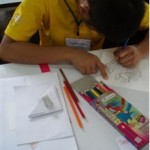
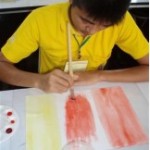
This is a really nicely written article- makes the processes of art therapy accessible to people who might be making decisions about programs. Thank you!
Thank you for this article. It is very moving and powerful and a wonderful example of healing through the creatice process.
Yes, working with Art Therapy really enables the images from the sub conscious to be expressed, thus putting ‘things’ into perspective! I really enjoyed reading Sabines’s account of working with young offenders.It is sad that these young people are ignored to such a degree, and Art Therapy certainly enables them to explore the many possibilities by way of Sculpture, Drawing and Painting.Also introducing the Wool Crafts, ie weaving, crocheting, knitting can be a creative experience.The examples of the Seals really was beautiful and probably helped that child to detatch from a divorced parenting, that is so hard for children to cope with in the World. All these mixed Emotions around a child can be really conflicting for some, yes, Art Therapy certainly can help the “young” to find themselves through expressing themselves out on paper, with clay, or other Medias, good, bad, or indifferent.Art Therapy helps people to Create and releases ideas that need to be expressed, cleansing,and purifying for the Soul.It helps people to find their “way”, even through a difficult childhood. We were so fortunate to be nourished, and grateful to Art Therapy for making us aware of just how much work there is “out there” in the World.Been recovering from another bout of Aneamia, and during recooperation decided to make some colourful Teacosies, crocheting circles, stitching them to form a “crown, then lines of knitting, in circles, and a spout. Am calling it “Any old Way Teacosies”, as sometimes,that is the way the tea is poured from the teapot “Any Old Way”. Thought I would share that with you. These young people who feel lost, in more ways than one, can find their “way” in Art Therapy by experimenting, making a few mistakes on the surface of the “Board”, by doodling patterns, dribbling paints, melting wax crayons, and fashioning Wool, to create something out of “any old way”. Just a bit of “fun”, I was fatigued again, but these “teacosies” have regenerated energy.Thankyou for your interesting remarks about Art Therapy with young people. Good Luck with your efforts.
I wish i was a child in Bangkok now.
It is important to acknowledge and validate for youth that life is not always going to go the way we (and they) want it to. They already know that to be true. Affirming them and empowering them to imagine and create something better for themselves is an incredible gift to them and to society. Art Therapy is powerful and you show us in a poignant and touching manner , the way of the heart. Thank You
Thank you for helping Thai children. There are many complicated social problems in Thailand, especially for young children. I wish art therapy can resolve their problems in long run. Thank you for caring our children.
Thank you for this article. I found the black mark technique quite interesting.
Personally, as an art therapist, I would not recommend drawing on the work of a patient or client, particularly a deprived or traumatized child or adolescent. This may have worked in Thailand, and there are aspects to this directive which are well-conceived, but I work in a jail with adolescent boys who would feel very disrespected if anyone were to draw on their work without permission. And I wouldn’t blame them. Something should be said at the start to warn them that there may be adjustments made to their work, and their permission should be sought.
Art therapy for children is such a powerful medium. Thank you for sharing this post. I will be heading to Thailand in January and would love to donate to the cause if I can. I was recently introduced into the organisation Terre des Hommes. It is an international org that works towards protecting the rights of children and equitable development. There are art therapists currently working with Syrian children and treating them with art, laughing and music therapy to deal with PTSD. They are making incredibly positive impressions on this war-stricken children.